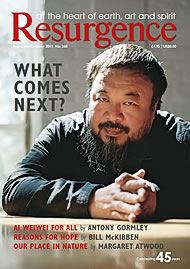There is so much that puts these two wonderful books together: both photographers work without cameras; both present series of work that are rooted in the cycles of the natural world of seasons and time; both live in Devon on the edge of Dartmoor; and both push the technical boundaries of photography, employing both early and highly contemporary methods. And yet the outcomes are so astonishingly different.
The titles of the two books give us our orientation within the natural, experienced world, yet both, in actuality, open up doors beyond, in a phrase from one of the essays, “on the edge of certainty”.
Whilst Garry Fabian Miller’s early work showed the progress of time in a series of leaves, or the sea horizon through the seasons, 30 years on his images have moved into pure abstraction, making images of light itself. This is a language of geometry, squares and circles in luminous colour. Only the titles link them obviously back to the artist’s inspiration in his response to changing light and season.
Photographic paper is flooded with light refracted through coloured and clear glass vessels containing oil and water to produce images that attempt to seize time and light, in the artist’s own words “making things visible that have never been seen before…the embodiment of special moments.”
Most of the work in this book comes from two years of intense experimentation. As the availability of the photographic paper he used became doubtful, he strove to forge a reference library for future work. The most recent work emerging from this enlarges the image until it encloses the viewer. Sadly for those who have not seen them in recent exhibitions, I have to say that the works in their full size have a power that the book cannot do justice to. However, what we do have is an enormously valuable record of the process.
Elemental records all the major series of Susan Derges’ practice, over 25 years of work. It is more obviously organic and representational than Miller’s. Where his finished images, whatever their natural inspiration, are abstract and geometric, Derges’ are flowing, revealing more chaotic moments of process, the emergence of tadpoles, the drift of water, the shadow of leaves.
Her ‘darkroom’ is extended into the landscape, and the process becomes the image. In the River series the water is illuminated by a swift flash of light or slowly by moonlight directly onto photographic paper immersed in the stream. In the series Under the Moon, she “...brought photographs I had made of the moon into the darkroom, combining them with direct prints of water and branches that were vibrated by sound…”
It is telling that the accompanying essays emphasise participation; the attempt to make visible the relationships between the moon, water, living matter – and, by implication, the observer – that are current in contemporary ideas of qualitative and holistic science. But above all, these images are beautiful. From the incandescent image of a bluebell pod against a black background, to the midnight streams and moon images, there is a depth of beauty and mystery here that is never soft.
These are extraordinary books and could change the way you see the world.
Gay Watson is a Trustee of Dartington Hall.






